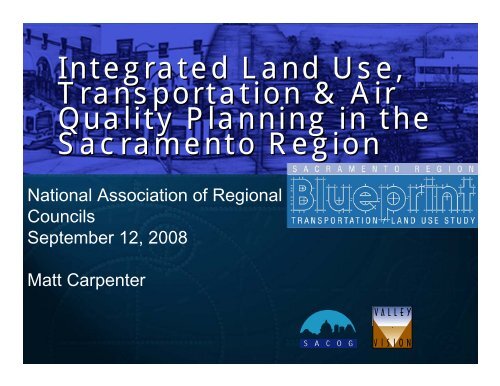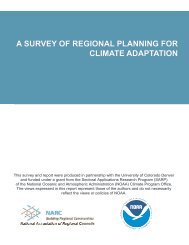Matthew Carpenter - NARC
Matthew Carpenter - NARC
Matthew Carpenter - NARC
You also want an ePaper? Increase the reach of your titles
YUMPU automatically turns print PDFs into web optimized ePapers that Google loves.
Integrated Land Use,<br />
Transportation & Air<br />
Quality Planning in the<br />
Sacramento Region<br />
National Association of Regional<br />
Councils<br />
September 12, 2008<br />
Matt <strong>Carpenter</strong>
Sacramento Area<br />
Council of<br />
Governments<br />
6 counties<br />
22 cities<br />
2.2 million people
Key Integrated Land<br />
Use, Transportation<br />
& Air Quality Efforts<br />
• Metropolitan Transportation Plan (MTP)<br />
adopted in 2002 – disappointing performance<br />
• Blueprint growth strategy adopted 2004<br />
• New MTP adopted 2008 – better performance<br />
• Rural-Urban Connections Strategy – launched<br />
in 2008
How to Best<br />
Manage Growth
Seven principles of<br />
smart growth
Base<br />
Case<br />
Urban<br />
Footprint<br />
— 2050
Preferred<br />
Scenario<br />
Urban<br />
Footprint<br />
— 2050
Less Urban Land
Less Farmland<br />
Conversion
MTP 2035: Next<br />
Step in Blueprint<br />
Hurley Way and Fulton Avenue, Sacramento<br />
County<br />
A Corridor at the Start of the<br />
MTP Planning Process…<br />
Hurley & Fulton, Sacramento County
MTP 2035: Next<br />
Step in Blueprint<br />
Future Potential of the Corridor<br />
Hurley & Fulton, Sacramento County
MTP 2035:<br />
Shorter Trips to<br />
Serve Future<br />
Land Uses<br />
• budget % increase is greatest for<br />
bike/pedestrian and Blueprint supportive<br />
programs (AQ, community design, etc.)<br />
• increased $ support for road maintenance &<br />
transit operations
MTP 2035: Cost-<br />
Effective Solutions<br />
with Good<br />
Performance Benefit<br />
Even with Financial Constraints & Trade-Offs…<br />
Most vehicle travel measures per household<br />
improve from today<br />
eg) Congested Vehicle Miles of Travel per<br />
household is significantly lower than 2002 MTP
Cost-Effective<br />
Solutions with Good<br />
Performance<br />
Benefit
Quality Transit For<br />
More<br />
• New Transit<br />
Options<br />
• 62% of local bus<br />
routes with 30min<br />
or better service<br />
(vs. 8% in 2005)<br />
• 58% of<br />
Environmental<br />
Justice households<br />
living within ¼ of a<br />
15min transit line<br />
(vs. 21% in 2005)
Quality Transit<br />
For More
Limited Road<br />
Expansions<br />
• complete arterial grids for local trips and strategic<br />
freeway improvements for longer distance travel<br />
• focus on cost-effective operational improvements<br />
(eg. ITS) and fixing critical bottlenecks (eg.<br />
interchanges)
Connecting<br />
Climate Change to<br />
Land Use &<br />
Transportation<br />
Land Use &<br />
Transportation<br />
MTP Strategies<br />
& Good<br />
Performance<br />
Measures<br />
EIR<br />
Mitigation<br />
Measures<br />
Air Quality<br />
Transportation<br />
Control<br />
Measures<br />
Greenhouse Gas<br />
Emissions
California Climate<br />
Change<br />
Requirements<br />
• AB32 – 1990 GHG levels by 2020<br />
• Executive Order – 80% reduction by 2050<br />
• California Environmental Quality Act<br />
(CEQA) – plans and projects required to<br />
assess GHG impacts (Attorney General<br />
actively enforcing)
Transportation & Land<br />
Use Sector Produces<br />
Vehicle Miles Traveled<br />
• Vehicle Miles Traveled (VMT) is an important,<br />
but not the only, component of Greenhouse Gas<br />
emissions<br />
• Vehicle Types and Fuel Technologies are the<br />
other two components
10% per household<br />
CO2 reduction by<br />
2035
CEQA GHG Mitigation<br />
Measures for the<br />
MTP 2035<br />
• Condition funds on green construction practices<br />
• Develop regional climate action plan<br />
• Create alternative fuel vehicle and infrastructure<br />
toolkit<br />
• Public education program<br />
• Regional parking policy<br />
• Program to reduce GHG emissions for school<br />
trips<br />
• “Complete Streets” policy<br />
• Rural-Urban Connections strategy
Challenges in Our<br />
Rural Areas<br />
Sacramento Area Council of Governments
Loss of Farmland<br />
Sacramento Area Council of Governments
Agricultural<br />
Commodities<br />
Sacramento Area Council of Governments
Food Chain<br />
Employment<br />
Sacramento Area Council of Governments
Opportunities in Our<br />
Rural Areas<br />
Sacramento Area Council of Governments
Approach to<br />
Integrated Regional<br />
Planning<br />
Sacramento Area Council of Governments
Information-driven planning<br />
Base Case<br />
Scenario:<br />
(MEPLAN -<br />
Land<br />
Economics)<br />
Alternative<br />
Scenarios:<br />
(PLACE 3 S -<br />
Relative impacts)<br />
Regional<br />
Transportation:<br />
(Activity-Based<br />
Travel Model)
Citizen Input<br />
—5,000 for Blueprint<br />
—8,000 for MTP
Elected Officials<br />
Workshops
TALL ORDER: Moving the Region Forward<br />
Sacramento Area Council of Governments • Valley Vision • KCRA 3
Three Scenarios<br />
TALL ORDER: Moving the Region Forward<br />
Sacramento Area Council of Governments • Valley Vision • KCRA 3
TALL ORDER: Moving the Region Forward<br />
Sacramento Area Council of Governments • Valley Vision • KCRA 3
TALL ORDER: Moving the Region Forward<br />
Sacramento Area Council of Governments • Valley Vision • KCRA 3
TALL ORDER: Moving the Region Forward<br />
Sacramento Area Council of Governments • Valley Vision • KCRA 3
TALL ORDER: Moving the Region Forward<br />
Sacramento Area Council of Governments • Valley Vision • KCRA 3
For More Information<br />
Matt <strong>Carpenter</strong><br />
mcarpenter@sacog.org<br />
Sacramento Area Council of<br />
Governments






